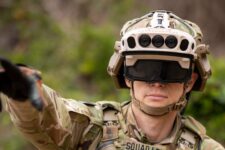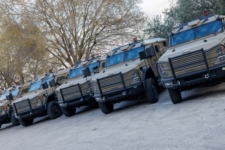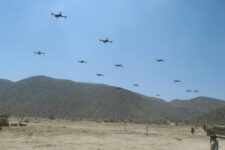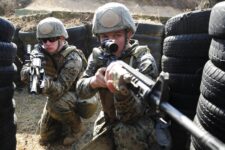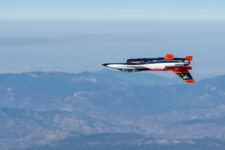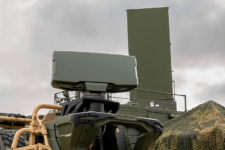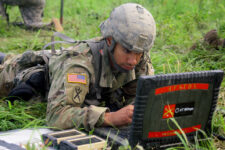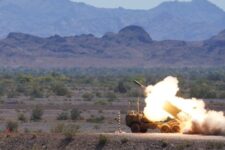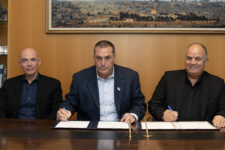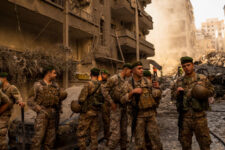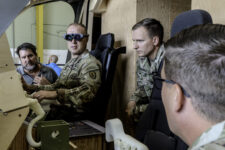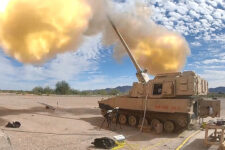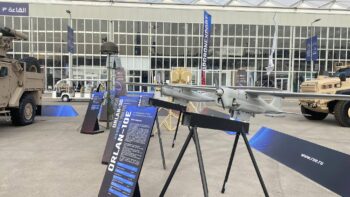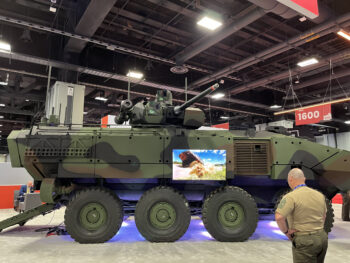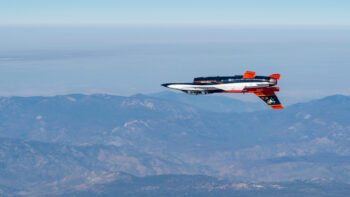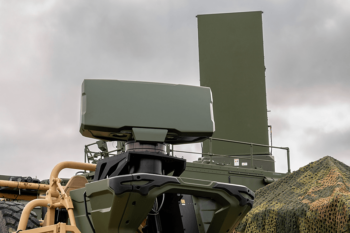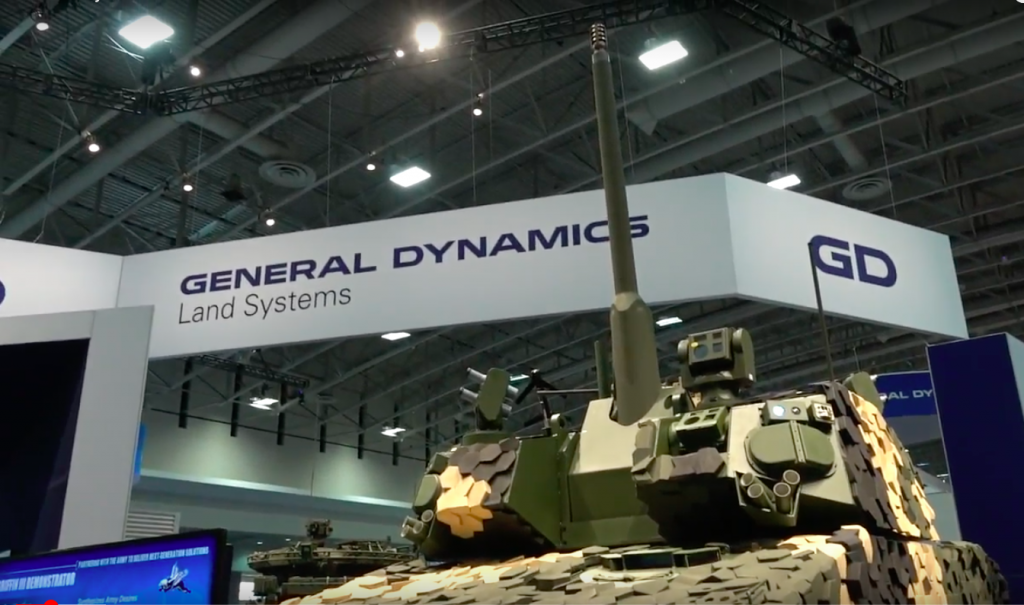
General Dynamics’s Griffin III demonstrator showing off its 50mm autocannon.
WASHINGTON: Unlike rival Rheinmetall with its sleek Lynx armored vehicle, General Dynamics doesn’t know what its proposed replacement for the M2 Bradley would look like. But that’s exactly according to plan.
At this early stage in its Optionally Manned Fighting Vehicle program, the Army is not asking for a detailed design, or even a rough concept for a specific vehicle. Instead, General Dynamics OMFV director Ray Kiernan told me in an interview, the Army wants companies to come up with a flexible approach that explores a wide range of possibilities – the state of the art and the art of the possible in armored vehicle design.
Those studies, in turn, will help the Army turn its current broad “characteristics” into specific performance requirements. Once the Army has specific requirements, then the competing companies can produce specific designs to meet them.
But right now, the Army wants to consider the full range of options, from a souped-up Bradley carrying five or six infantry passengers, to a massive machine carrying 30 infantry, to a mini-tank carrying just one. “You could have solutions across that whole spectrum,” Kiernan told me. “What we believe General Dynamics’ role to [be] is to apply our tools to help the Army understand where the optimal solution lies within that trade space.”
That stands in stark contrast to the Army’s initial, cancelled attempt to build OMFV. Back in 2020, the service laid out rigid requirements, then demanded companies deliver a fully functioning prototype at their own expense. In the end, only General Dynamics delivered a prototype by the deadline – only for it not to meet the requirements, which the Army later admitted were unrealistic. So, in a bold move, the service rebooted the entire OMFV program with a more realistic schedule, broad “characteristics” instead of requirements, and an entirely new approach to competition.
This time around, the Army isn’t asking companies to build a vehicle, not yet. Instead, “we need to build the system models,” said Kiernan. “We need to do the trade studies to analyze the various technology options and how they fit together to make a balanced solution.”

The M2 Bradley has been repeatedly upgraded since its introduction, but after 40 years in service, the vehicle is reaching its limits.
AI, Electronics, & Open Architecture
While the Army’s keeping its options open, certain unifying themes are already clear – technologies that any solution must include to meet the Army’s requirements. Most obviously, as the name Optionally Manned Fighting Vehicle implies, the Army wants extensive automation to supplement the human crew – or, for some missions, to replace them.
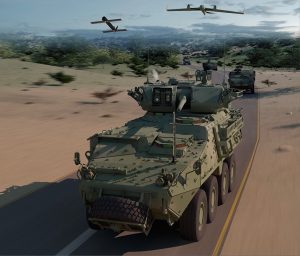
Concept art of AeroVironment Switchblade drones operating with a modified General Dynamics Stryker.
More broadly, OMFV must accommodate a host of highly sophisticated electronics, from sensors and targeting systems to network communications to share threat and target data across the force – all enabled by artificial intelligence. OMFV must be able to update that hardware and software rapidly as technology advances and threats mutate, using what’s called modular open system architecture to enable plug-and-play insertions of new tech — including technologies not even envisioned today. And all of this must be resilient against cyber attack and electronic jamming.
“If you don’t establish those things as a fundamental part of your vehicle up front and really build the vehicles around those capabilities in an open architecture,” Kiernan said, “you’re going to struggle to really deliver the kind of transformational capability that the Army wants.”
To pull in all the necessary expertise, General Dynamics Land Systems has brought together a wide-ranging — even eclectic — team of companies:
- Applied Intuition is not a traditional defense contractor. It builds software to test and develop autonomous vehicles, with a focus on the market for civilian self-driving cars. ”They’re really a market leader in autonomy and artificial intelligence, as well as modeling and simulation, [to] revolutionize how transportation technologies can be applied,” Kiernan said. “Non-traditional for the defense world, but they bring us a lot of artificial intelligence expertise.”
- AeroVironment is a defense contractor, but not a traditional ground vehicle company: They’re most famous for small drones, from the Army’s hand-launched Raven scout, to the Jump-20 VTOL drone, to the Switchblade loitering munition. AeroVironment teamed with General Dynamics to launch its mini-drones from GD’s vehicles, giving each vehicle commander his own personal eye in the sky – and perhaps the capability to launch short-range airstrikes as well.
- General Dynamics Missions Systems is basically the electronics division of GD. For OMFV, Kiernan said, Mission Systems brings expertise in battle management systems, cybersecurity, and sensor integration.
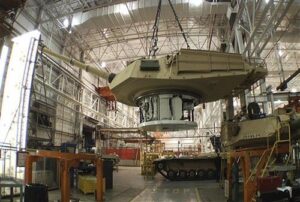
An M1 Abrams turret at General Dynamics’ Lima factory, the only factory in the US capable of building main battle tanks.
Finally, there’s General Dynamics Land Systems itself, most famous for building, sustaining, and repeatedly upgrading the Reagan-era M1 Abrams at its Lima tank plant. Decades of improvements to the M1 have taught GDLS a lot about what it takes to keep an Army vehicle cutting-edge over time, Kiernan said. Meanwhile, work on the Army’s 8×8 Stryker, the prototype Mobile Protected Firepower (MPF) light tank, and Britain’s Ajax family of vehicles have kept GDLS in the business of building new designs as well.
GDLS also built a series of concept vehicles, sometimes known as Griffin, that gave rise to both its MPF design and its offering for the initial version of OMFV. While that competition was canceled, Kiernan says Griffin and other past projects are still highly relevant for the rebooted OMFV program. Technologies includes the 50 mm autocannon featured on Griffin III, which is one potential armament option for OMFV, and extensive work on automotive components, automation, open architecture, and electrical systems to power modern electronics.
“We have a wealth of information from the investments we’ve done,” Kiernan said. “It provides us with a very unique set of data that acts as a starting point when we start to explore the trade space.”
Russia overtakes all of Europe on defense spending in key metric: IISS military balance
The spending figures included in the think tank’s newly published Military Balance report also show that in real-terms, Russia’s military expenditure increased by over 40 percent in 2024.

